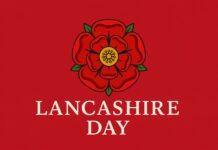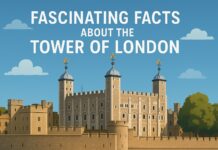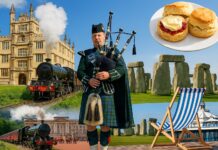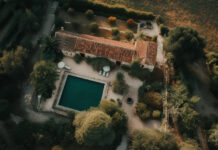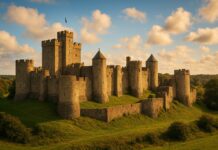The United Kingdom blends ancient history with modern innovation, royal tradition with quirky humour. Yet beyond the postcard images of castles, red buses, and rolling countryside, there’s a trove of surprising stories that reveal how the UK has shaped our language, sport, science—and even our tea breaks.
This list is crafted for curious travellers, students, and trivia lovers who want facts with context. Each item explains the “why it matters,” adds a practical tip or example, and clears up common myths. Expect clear definitions (Great Britain vs the UK), cultural insights (why Brits queue), and evidence-backed nuggets (how England documented sparkling wine before Champagne fame).
By the end, you’ll have 25 well-explained facts you can quote with confidence—ideal for travel planning, classroom discussion, or your next pub quiz.
1. Brits Drink 100 Million Cups of Tea Daily
Tea is woven into British life—from “builders’ tea” on construction sites to elegant afternoon teas in hotels. Estimates from industry bodies put daily UK consumption around 100 million cups, which adds up to roughly 36 billion a year. Why so much? Tea historically arrived through maritime trade and became a democratic comfort: affordable, warming, and sociable. Try this: sample regional favourites like Yorkshire Tea or a strong Assam, and pair with a scone, clotted cream, and jam for a classic afternoon ritual. Fun myth-buster: milk-first vs milk-after is still debated; tradition often depended on protecting delicate porcelain, not fixed etiquette.
Quick tip: Visit a traditional tearoom in Bath, York, or Harrogate to compare blends.
2. The First Postage Stamp Began Here
The Penny Black (1840) was the world’s first adhesive postage stamp, featuring Queen Victoria’s profile. It solved a practical problem: prepaying for mail, replacing complex, recipient-paid systems. This innovation kicked off modern global postal networks and design traditions that philatelists still study. Because the UK invented stamps, it is the only country not required to print its name on them—royal imagery suffices for identification. Collectors prize early issues for their engraving and condition.
Try this: At London’s Postal Museum, ride the Mail Rail and see how underground trains once shuttled letters beneath the city.
3. The Monarch Travels Without a Passport
UK passports are issued in the monarch’s name, so the sovereign does not need one to travel. Historically, letters of introduction and diplomatic protocols handled royal movements long before standard passports existed. Other royal family members, however, do carry passports like everyone else. It’s a neat example of constitutional tradition meeting modern bureaucracy.
Did you know? The monarch also doesn’t need a driver’s licence in the UK—another quirk arising from the sovereign’s unique legal status.
4. Stonehenge Predates the Pyramids
Stonehenge dates back over 5,000 years, older than Egypt’s Giza pyramids. Built in phases using massive sarsen stones and imported bluestones, it showcases sophisticated Neolithic engineering, astronomical alignment, and social organisation. Scholars debate whether it functioned as a ceremonial site, an ancient calendar, or a place of healing. Visit at sunrise or sunset to appreciate its alignment with solstices, when light threads through the trilithons.0909-
Quick tip: Combine a Stonehenge trip with Avebury and Silbury Hill to experience a wider prehistoric landscape.
5. The World’s Longest-Running Play Is in London
Agatha Christie’s The Mousetrap opened in London’s West End in 1952 and has become the longest-running play in theatre history. Its enduring appeal lies in tight plotting, cosy suspense, and an audience pact not to reveal the killer. The show reflects Britain’s mid-century love of mystery fiction and the West End’s capacity to sustain long-running hits.
Try this: Pair your theatre night with a pre-show set menu in Covent Garden; many restaurants time courses for curtain-up.
6. Cheese Rolling Is a Real (and Wild) Sport
At Gloucestershire’s Cooper’s Hill Cheese-Rolling, competitors chase a wheel of Double Gloucester down a steep slope. It’s part tradition, part daredevil descent, with tumbles almost guaranteed. The event captures British eccentricity: joyful, communal, and slightly bonkers. Safety marshals and medics now support the spectacle, but the spirit remains delightfully unfiltered.
Quick tip: If you prefer to stay upright, watch from the sidelines and sample local cheeses at nearby markets.
7. Scotland’s National Animal Is the Unicorn
The unicorn, a medieval symbol of purity and strength, has represented Scotland for centuries and appears on royal heraldry. Why a mythical creature? It stood for untamed power and virtue—qualities Scottish heralds admired. You’ll spot unicorns carved into palaces, fountains, and coats of arms, often chained to signify a noble yet controlled force.
Did you know? On the UK’s Royal Arms in Scotland, the unicorn replaces the English lion’s position of prominence.
8. Chicken Tikka Masala Became a National Favourite
Often cited as a modern “national dish,” Chicken Tikka Masala likely evolved in the UK, where South Asian chefs adapted grilled chicken tikka with a creamy tomato sauce to British tastes. The dish reflects the UK’s multicultural palate, shaped by migration, trade, and neighbourhood curry houses. While not an “official” designation, its popularity symbolises culinary fusion and community.
Try this: Explore Birmingham’s “Balti Triangle” or London’s Brick Lane for regional variations and spice levels.
9. Europe’s Longest Place Name Is in Wales
Welcome to Llanfairpwllgwyngyllgogerychwyrndrobwllllantysiliogogogoch, often shortened to Llanfair PG. The name is largely a 19th-century creation to attract visitors and means, roughly, “St Mary’s church in the hollow of the white hazel near the rapid whirlpool by St Tysilio’s of the red cave.” It’s playful, promotional, and proudly Welsh. Railway signs and souvenirs celebrate the tongue-twister.
Quick tip: Learn a few Welsh phrases—“Diolch” (thank you) goes a long way with locals.
10. England Documented Sparkling Wine Before Champagne Fame
In 1662, English scientist Christopher Merret described adding sugar to wine to induce a second fermentation—key to making sparkling wine. England’s strong glass bottles, developed for coal-fired furnaces, helped contain the pressure. While Champagne later perfected and popularised the tradition, Merret’s paper shows England’s early role in the science. Today, English sparkling wines from Sussex and Kent win major awards.
Try this: Tour vineyards in the South Downs; chalk soils echo those in Champagne.
11. Great Britain Isn’t the United Kingdom
Great Britain is the island comprising England, Scotland, and Wales. The United Kingdom is Great Britain and Northern Ireland under one sovereign state. The distinction matters for geography, politics, sport, and identity. For instance, Team GB competes at the Olympics, while football teams represent England, Scotland, Wales, and Northern Ireland separately.
Quick tip: When writing, use “British” for UK-wide contexts and “English/Scottish/Welsh/Northern Irish” for nation-specific references.
12. The UK Gave the World Many Sports
Modern football (soccer), rugby, cricket, tennis, and golf formalised rules in the UK during the 19th century, as public schools and clubs codified play. This rule-making culture helped sport spread globally through trade, empire, and media. Today’s World Cups and Grand Slams trace their structures to British institutions.
Did you know? The Football Association (FA) published the first unified rules in 1863; Wimbledon began in 1877 as a lawn tennis championship.
13. Loch Ness Is Scotland’s Mysterious Deep
Loch Ness, near Inverness, is among the UK’s deepest and largest freshwater lakes by volume. Its dark, peat-stained waters and long, narrow shape feed the legend of “Nessie.” Whether you’re a sceptic or believer, the area offers boat tours, Urquhart Castle views, and excellent hiking. The myth supports local tourism while sparking ongoing sonar surveys and folklore talks.
Quick tip: Visit the Loch Ness Centre for exhibits on geology, sightings, and scientific investigations.
14. Edinburgh Built Over Its Own Streets
In Edinburgh’s Old Town, vaults and closes—like Mary King’s Close—were effectively sealed or built over during urban changes from the 17th century onward. Today, guided tours explore preserved rooms and alleyways, offering a vivid look at plague-era life, commerce, and architecture. It’s a tangible time capsule that shows how cities repurpose space across centuries.
Try this: Contrast the medieval Old Town with the Georgian New Town’s planned symmetry for a full urban-history lesson.
15. London Sits in a Natural Basin
Greater London occupies a geological basin formed of clays, sands, and gravels around the Thames. The basin influences drainage, building foundations, and—even historically—brickmaking (London stock bricks used river clay). It also helps explain the city’s meanders and flood risk, managed today by the Thames Barrier and tidal strategies.
Did you know? London’s subsurface clay swells and shrinks with moisture, affecting building movement—a challenge engineers plan for.
16. One of the World’s Largest Transport Networks
London’s transport web—Underground, Overground, DLR, buses, trams, river services, and bikes—moves millions daily. The Tube spans eleven lines, with contactless payment and the modern Elizabeth line connecting east–west at high frequency. Interchanges like King’s Cross St Pancras knit rail to Eurostar, making London a continental gateway.
Quick tip: Use a contactless card or device—fares cap daily and weekly, often cheaper than paper tickets.
17. England’s Landscape Is Largely Lowland
While the Lake District, Peak District, and Pennines offer dramatic uplands, much of England is low-lying or gently rolling—ideal for agriculture and dense settlement. East Anglia’s fens and the Thames Valley illustrate this flatter profile. The contrast with Wales and Scotland’s mountainous regions shapes climate, hiking styles, and regional economies.
Try this: Walk a segment of the South Downs Way for big skies, chalk ridges, and Iron Age hill forts—no mountaineering required.
18. English Isn’t the Only UK Language
The UK recognises multiple languages: Welsh, Scottish Gaelic, Irish (in Northern Ireland), Scots, and Cornish, alongside British Sign Language. Welsh enjoys strong institutional support, with bilingual signage and media; Gaelic place names dot the Highlands and Islands. Language revival projects reflect community identity and heritage.
Quick tip: In Wales, you’ll hear “Croeso” (welcome). In Scotland, “Slàinte” to toast good health.
19. Traditional Haggis Can’t Be Imported to the US
Since the 1970s, the US has prohibited foods containing sheep lung, a key ingredient in traditional Scottish haggis. As a result, American versions often modify recipes. In Scotland, you can try it authentically—rich, peppery, and usually served with “neeps and tatties” (turnips and potatoes). The rule highlights how food culture intersects with regulation.
Try this: Sample haggis bonbons in Edinburgh gastropubs if a full plate feels daunting.
20. England Holds Most of the UK’s Population
England accounts for the vast majority of the UK’s population and has higher average urban density than the other nations. This concentration fuels vibrant labour markets, cultural institutions, and transport demand, while also raising questions about housing and regional balance.
Did you know? London alone hosts a population comparable to some European countries—explaining the scale of its services and global reach.
21. Afternoon Tea Is a Social Institution
Introduced in the 19th century, afternoon tea bridges lunch and dinner with sandwiches, scones, and pastries. It’s less about ceremony and more about sociable pause—a ritual of hospitality. Hotels refine it with themed menus; homes keep it simple. Pair strong black tea (Assam or Darjeeling) with lemon or milk—both are correct depending on the blend.
Quick tip: Book well ahead for famous services at Claridge’s or Fortnum & Mason; dress codes may apply.
22. Royal Birthday and Anniversary Messages
For more than a century, the sovereign has sent congratulatory messages to UK residents marking their 100th birthdays and major wedding anniversaries. It’s a small but cherished tradition that connects citizens to the Crown. Many families frame the card, which arrives via the Anniversaries Office after verification.
Try this: If a relative approaches a milestone, apply through local registrars or online guidance to receive the greeting.
23. Golf Has Deep Scottish Roots
Golf flourished in Scotland by the 15th century; a 1457 act even banned it temporarily because it allegedly distracted from archery practice—proof it was already popular. Links courses exploiting coastal dunes shaped the sport’s strategy: wind, firm turf, and creative shot-making. St Andrews is often called the “home of golf,” hosting The Open and stewarding rules.
Quick tip: Play a lesser-known links like North Berwick or Cruden Bay for classic strategy without major-championship crowds.
24. Brits Are Famous for Queues—and Small Talk
The UK has a reputation for orderly queuing, reflecting social norms about fairness in crowded spaces. Similarly, polite weather chat (“Bit nippy today!”) acts as a social lubricant—safe, shared, and uncontroversial. These habits help strangers cooperate in dense urban settings and keep interactions courteous.
Try this: When joining a line, find the end and make eye contact; a light comment about the drizzle never hurts.
25. British Ideas Changed the Modern World
From the steam engine and industrial factories to the telephone (Bell), the postage stamp, and the World Wide Web (Tim Berners-Lee), British-origin innovations reshaped communication, transport, and industry. Universities, learned societies, and publishing networks fostered debate and dissemination.
Did you know? Many museums—Science Museum (London), Museum of Science and Industry (Manchester)—trace these breakthroughs with hands-on exhibits.
FAQs
1) Is Great Britain the same as the UK?
Not exactly. Great Britain refers to the island comprising England, Scotland, and Wales. The United Kingdom (UK) includes all three plus Northern Ireland, forming the full title: The United Kingdom of Great Britain and Northern Ireland.
2) What’s the UK’s most visited prehistoric site?
That would be Stonehenge—a world-famous Neolithic monument in Wiltshire. Its massive standing stones, mysterious origins, and alignment with the solstices continue to captivate millions of visitors each year.
3) Did England really invent sparkling wine?
In a way, yes. In 1662, English scientist Christopher Merrett described the process of adding sugar to wine to create bubbles—well before the French refined it into Champagne. So while England may have invented it, France made it iconic.
4) What unusual UK sport should I watch?
Don’t miss the wild spectacle of Cooper’s Hill Cheese Rolling in Gloucestershire. Contestants hurl themselves down a steep hill in pursuit of a runaway cheese wheel. It’s chaotic, comical, and best enjoyed from a safe distance!
5) Which UK languages will I encounter?
English is spoken everywhere, but you may also hear:
– Welsh in Wales
– Scottish Gaelic and Scots in Scotland
– Irish in Northern Ireland
Bilingual signage is common in many regions, reflecting the UK’s rich linguistic diversity.
Conclusion
The UK is more than landmarks and royalty; it’s a living laboratory of ideas, rituals, and stories. From unicorns on coats of arms to scientific papers that fizzed wine into history, these facts show a country that’s playful and profound at once. Use them to plan smarter journeys, enrich lessons, or simply win your next quiz night.
Call to action: Want deeper guides to London, Edinburgh, or Welsh language travel? Tell me your route, and I’ll tailor an itinerary and reading list.









